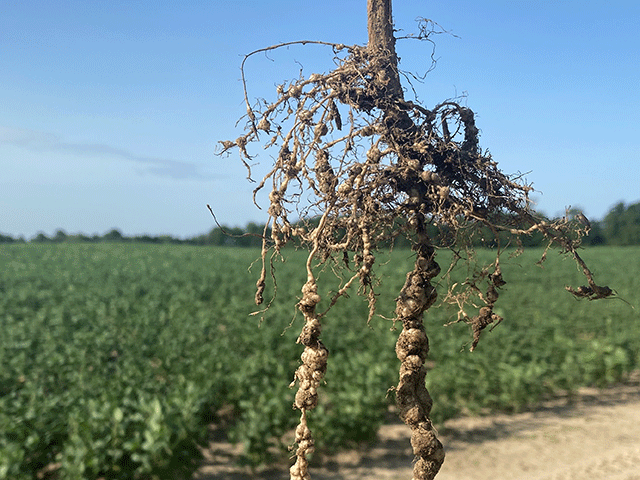More Nasty Nematodes
Soybean Nematodes Get Southern Exposure
DECATUR, Ill. (DTN) -- Below ground pests are tough adversaries. Southern soybean farmers are learning first-hand as they face additional nematode threats.
Soybean cyst nematode (SCN) was the main parasitic nematode concern for many Southern regions until the 1980s and it remains the primary yield worry for soybean states in the Midwest and farther north. However, recent focus has shifted to additional threats from the southern root-knot (SRKN), reniform and lesion nematodes, according to University of Arkansas Plant Pathologist Travis Faske.
In his state, SRKN is the most important, Faske said. Found in nearly all soybean-producing counties in Arkansas, it can cause greater than 70% yield loss when a susceptible variety is planted in a field with a high population density of root-knot nematodes.
As a result, The SCN Coalition has announced it is expanding educational outreach to other parasitic nematodes. A partnership between public, checkoff and private companies, the group works to create awareness and increase the number of farmers actively managing for nematodes as a pest.
GALL OF IT ALL
Unlike SCN, in which foliar symptoms are typically absent or mild until nematode numbers develop to high levels, SRKN announces its presence. "Within a green field, a bull's-eye will become visible if high populations of SRKN are present on a susceptible variety," Faske said. "Plants will turn yellow, be stunted and prematurely die. That's when a grower recognizes they have a problem that needs to be investigated."
Another telltale symptom is the galls that develop on the soybean roots during the growing season. "When soybean roots are developing, the second-stage juvenile migrates up to the root system to establish a feeding site," Faske said. "While the SCN adult females break through the root surface and attach to the exterior of the root, SRKN enters and stays in the root and causes it to swell, which is called a gall.
P[L1] D[0x0] M[300x250] OOP[F] ADUNIT[] T[]
"Each of these large galls acts like a rock in the middle of a small stream and reduces water uptake. That's why plants infected with SRKN die prematurely," he said.
Cut open, the gall looks like root tissue, compared to soybean nodules, which are a healthy pink. Gall size can depend on soybean susceptibility, growth stage and species of root-knot nematode.
"Unlike SCN, there are several species of root-knot nematode that can infect soybeans," Faske told DTN. His work in Arkansas is primarily on southern root-knot nematode (Meloidogyne incognita).
TAKE THE TEST
Like SCN, anything that moves the soil moves other parasitic nematodes. "That's why it's important to detect what nematodes are in your soil," Faske said. "Growers in Arkansas can utilize free sampling supported by the soybean checkoff to determine what nematodes are present and at what population densities."
Cotton growing states are associated with the highest population densities and distribution of SRKN. "Soils in the northern U.S. soybean-growing areas are too cold for SRKN, but almost every crop that is grown in Arkansas, besides peanuts, is a host for SRKN, which makes it a challenge to manage," he added.
Faske recommends soybean growers test soil every three-to-five years to determine which nematodes are present and to see if population densities have changed. Nematodes are impossible to eradicate once established, so management to reduce numbers is important.
JOIN THE RESISTANCE MOVEMENT
While crop rotation with anything other than soybeans is key to management in SCN, these southern nematodes are tougher to outsmart. Corn, cotton, soybeans and grain sorghum are all hosts for the SRKN.
Peanut is a good rotation crop because SRKN do not develop a feeding site in the host and, therefore, reproduction is very, very low, Faske said.
With market signals tempting farmers to plant more soybeans and possibly second-year soybeans, there's good reason to seek resistant varieties. Faske has been evaluating soybean cultivars for host resistance, but he admits there's a need for more work in this area as options are lacking in Group IV soybeans, the maturity group often preferred in the Midsouth. Add the desire for specific herbicide traits and the shopping options shrink further.
The SCN Coalition (www.thescncoalition) has put together several videos featuring Faske as part of their "Let's Talk Todes" education campaign, sponsored by the United Soybean Board.
You can access the videos here: https://www.thescncoalition.com/…
For more information on field performance of resistance varieties in Arkansas go to: https://arkansascrops.uaex.edu/… https://www.uaex.edu/…
Pamela Smith can be reached at pamela.smith@dtn.com
Follow her on Twitter @PamSmithDTN
(c) Copyright 2021 DTN, LLC. All rights reserved.






